16种时态的被动语态
不同时态的被动语态
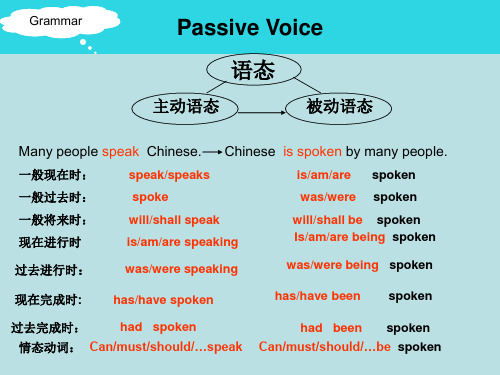
一般将来时:
现在进行时 过去进行时:
will/shall speak
is/am/are speaking was/were speaking has/have spoken had spoken
will/shall be spoken Is/am/are being spoken
was/were being spoken has/have been had been s被的方法:
• 1.主动语态的宾语 被动语态的主语 • 2.把谓语动词变成be+动词过去分词。(be 的形式由主动句的谓语动词时态 与被动句的主语决定。) He was laughed at by all the people. • 1)All the people laughed at him. 2) He will cut down a tree.
3)We can repair this watch.
4)Lucy is doing her homework. 5) The workers have built the bridge.
现在完成时:
过去完成时:
情态动词: Can/must/should/…speak
Can/must/should/…be spoken
Practice
• A)用法:1.不知或没必要说明动作执行者是谁。
were stolen • Eg: Some computer_____________ last night.(一些电脑昨晚被盗了) • 2.强调动作的承受者。 was broken by Mike.(玻璃被麦克打破了) • Eg: The glass ___________
Grammar
Passive Voice 语态
根据英语的16种时态及其被动语态例句,修改其中的名词:
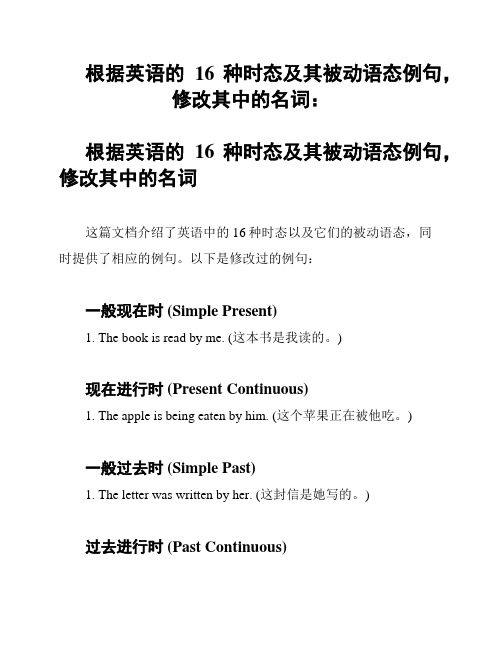
根据英语的16种时态及其被动语态例句,修改其中的名词:根据英语的16种时态及其被动语态例句,修改其中的名词这篇文档介绍了英语中的16种时态以及它们的被动语态,同时提供了相应的例句。
以下是修改过的例句:一般现在时 (Simple Present)1. The book is read by me. (这本书是我读的。
)现在进行时 (Present Continuous)1. The apple is being eaten by him. (这个苹果正在被他吃。
)一般过去时 (Simple Past)1. The letter was written by her. (这封信是她写的。
)过去进行时 (Past Continuous)1. The cake was being baked by them. (这个蛋糕当时正在被他们烤。
)将来一般时 (Simple Future)1. The concert will be attended by us. (这场音乐会将被我们参加。
)将来进行时 (Future Continuous)1. The report will be being written by him. (这份报告将会正在被他写。
)现在完成时 (Present Perfect)1. The movie has been watched by them. (这部电影已经被他们看过。
)过去完成时 (Past Perfect)将来完成时 (Future Perfect)1. The work will have been finished by tomorrow. (这项工作到明天将已经被完成。
)现在完成进行时 (Present Perfect Continuous)1. The book has been being read by her for hours. (这本书她已经读了几个小时了。
16种时态及语态总结
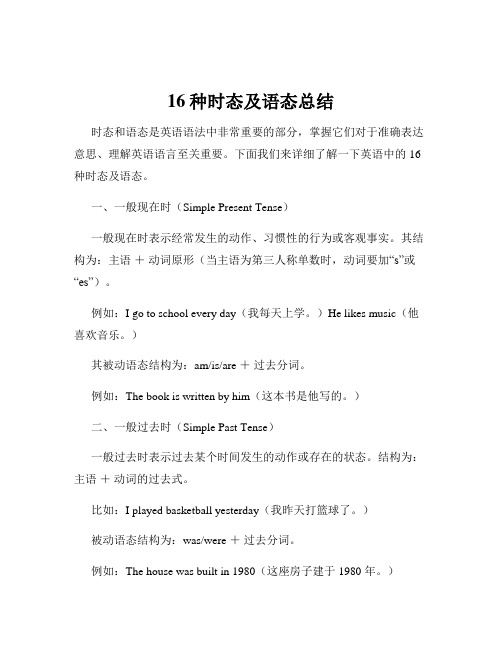
16种时态及语态总结时态和语态是英语语法中非常重要的部分,掌握它们对于准确表达意思、理解英语语言至关重要。
下面我们来详细了解一下英语中的 16 种时态及语态。
一、一般现在时(Simple Present Tense)一般现在时表示经常发生的动作、习惯性的行为或客观事实。
其结构为:主语+动词原形(当主语为第三人称单数时,动词要加“s”或“es”)。
例如:I go to school every day(我每天上学。
)He likes music(他喜欢音乐。
)其被动语态结构为:am/is/are +过去分词。
例如:The book is written by him(这本书是他写的。
)二、一般过去时(Simple Past Tense)一般过去时表示过去某个时间发生的动作或存在的状态。
结构为:主语+动词的过去式。
比如:I played basketball yesterday(我昨天打篮球了。
)被动语态结构为:was/were +过去分词。
例如:The house was built in 1980(这座房子建于 1980 年。
)三、一般将来时(Simple Future Tense)一般将来时表示将来要发生的动作或存在的状态。
结构有多种,常见的有:will +动词原形;be going to +动词原形。
例如:I will visit my grandparents next week(下周我将去看望我的祖父母。
)She is going to have a party(她打算举办一个聚会。
)其被动语态结构为:will be +过去分词;be going to be +过去分词。
比如:The meeting will be held tomorrow(会议将在明天举行。
)The show is going to be cancelled(这个演出将要被取消。
)四、现在进行时(Present Continuous Tense)现在进行时表示正在进行的动作。
英语16种动词时态和语态大全表2.2版

英语动词16种时态(被动语态)以do为例例1⼀一般时2进⾏行行时3完成时4完成进⾏行行时A现在①do被动(am/is/are done)⑤am/is/are doing被动(am/is/are being done)⑦have done被动(have/has been done)have been doing被动[have/has been being done]B过去②did被动(was/were done)⑥was/were doing被动(was/were being done)⑧had done被动(had been done)had been doing被动[had been being done]C将来③will do被动(will be done)will be doing被动[will be being done]will have done被动(will have been done)will have been doing被动[will have been being done]D过去将来④would do被动(would be done)would be doing被动[would be being done]would have done被动[would have been done]would have been doing被动[would have been being done]说明:①括号内为理理论上推出来的被动语态结构, 有些并不不⽤用②be going to do虽有和will do同样意义,但不不归类在⼀一般将来时⾥里里,属于现在进⾏行行时表将来英语动词的5种基本形式[基本]原型V[基本]三单V-s现在分词V-ing过去式V-ed过去分词V-ed中⽂文意思1be(am/is/are)is being was/were been是2become becomes becoming became become成为3begin begins beginning began begun开始4break breaks breaking broke broken打破5close closes closing closed closed关闭6do does doing did done做7drink drinks drinking drank drunk喝喝8drive drives driving drove droven开⻋车9findfindsfinding found found发现10get gets getting got got/gotten得到11go goes going went gone⾛走12have has having had had有13leave leaves leaving left left离开14move moves moving moved moved移动15put puts putting put put放下16say says saying said said说17smile smiles smiling smiled smiled微笑18start starts starting started started开始19swim swims swimming swam swum游泳20take takes taking took taken拿⾛走21work works working worked worked⼯工作英语16种动词时态例例句句(以do为例例)A1(⼀一般)现在present simple①I do my homework everyday.②China is a big country.A2现在进⾏行行present continuous①I am doing my homework now.②She is drinking water now.A3现在完成present perfect①I have done my homework. (I’m done with it. Now I can go out.)②I have waited for you for 2 hours. (Now you are here. Let’s go)A4现在完成进⾏行行present perfect continuous①I have been doing my homework for a long time.(I’m not donewith it. I have to keep doing it for another 2 two hours.)②I have been waiting for you for 2 hours. (You’re still on your way. Ihave to keep waiting for another 2 hours.)B1(⼀一般)过去past simple①I did my homework yesterday.②Japan invaded China in World War II.B2过去进⾏行行past continuous①I was doing my homework this time yesterday.B3过去完成past perfect①I told my mum that I had done my homework. (Then I went outfor a walk with my friend.)B4过去完成进⾏行行past perfect continuous①By the time my mum arrived home, I had been doing myhomework for 2 hours. ( But I wasn’t done. I had to keep doing itfor one more hour.)C1(⼀一般)将来future simple①I will do my homework tomorrow. (I don’t want to do it now.)C2将来进⾏行行future continuous①I will be doing my homework this time tomorrow. (Don’t call meout.)②I will be sleeping at 6:00 am tomorrow, so don’t call me. (I don’twant to be disturbed.)C3将来完成future perfect①I will have done my homework at 3:00 pm. (According to my plan,I can finish it at 3:00 pm this afternoon. So we can go to the parkand relax.)C4将来完成进⾏行行future perfect continuous①I will have been doing my homework for 2 hours by 3:00 pm. (AndI have to spend 1 more hour to finish it. I’ll finish it at 4:00 pm.D1(⼀一般)过去将来future simple in the past①I said I would do my homework after the class. (I promised myteacher)D2过去将来进⾏行行future continuous in the past①I said I would be doing my homework at 10:00 pm. (By that time,I would be doing my homework.)D3过去将来完成future perfect in the past①I promised I would have done my homework before going to bed.(My homework would be done before I went to bed.)D4过去将来完成进⾏行行future perfectcontinuous in the past①I said I would have been doing my homework for 2 hours by10:00 pm.。
英语各时态的主动句和被动句

一般将来时(Simple Future):主动语态:明天我将会见我的朋友。
(I will meet my friend tomorrow.)被动语态:我的朋友将被我明天见到。
(My friend will be met by me tomorrow.)主动语态:下个月我将搬到一个新的城市。
(I will move to a new city next month.)被动语态:一个新的城市将被我下个月搬到。
(A new city will be moved to by me next month.)主动语态:明年我将开始学习弹钢琴。
(I will start learning to play the piano next year.)被动语态:学习弹钢琴将被我明年开始。
(Learning to play the piano will be started by me next year.)现在进行时(Present Continuous):主动语态:我正在看电视节目。
(I am watching a TV show.)被动语态:电视节目正在被我观看。
(A TV show is being watched by me.)主动语态:他们正在制定新的计划。
(They are making new plans.)被动语态:新的计划正在被他们制定。
(New plans are being made by them.)主动语态:我们正在等待朋友的到来。
(We are waiting for our friend's arrival.)被动语态:朋友的到来正在被我们等待。
(Our friend's arrival is being waited for by us.)现在完成时(Present Perfect):主动语态:我已经完成了我的工作报告。
(I have finished my work report.)被动语态:我的工作报告已经被我完成了。
十六大时态和两种语态
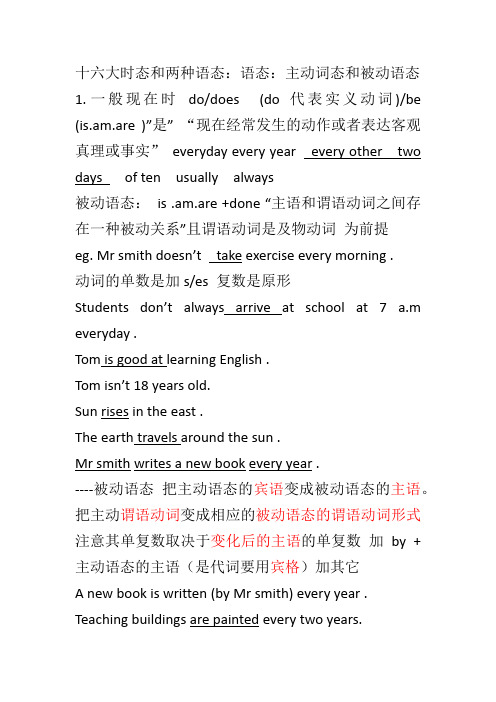
十六大时态和两种语态:语态:主动词态和被动语态1.一般现在时do/does (do代表实义动词)/be (is.am.are )”是”“现在经常发生的动作或者表达客观真理或事实”everyday every year every other two days of ten usually always被动语态:is .am.are +done “主语和谓语动词之间存在一种被动关系”且谓语动词是及物动词为前提eg. Mr smith doesn’t take exercise every morning .动词的单数是加s/es 复数是原形Students don’t always arrive at school at 7 a.m everyday .Tom is good at learning English .Tom isn’t 18 years old.Sun rises in the east .The earth travels around the sun .Mr smithwrites a new bookevery year .----被动语态把主动语态的宾语变成被动语态的主语。
把主动谓语动词变成相应的被动语态的谓语动词形式注意其单复数取决于变化后的主语的单复数加by +主动语态的主语(是代词要用宾格)加其它A new book is written (by Mr smith) every year . Teaching buildings are painted every two years.2.一般过去时did /be (was .were )”动作发生在过去”last night 3 days ago , last year , yesterday evening/morning . just now .”做……。
了”被动语态was/were+done “过去被……。
”eg. i stayed up to see a film last night .Tom read a novel about scientific research just now.A novel was read by Tom about scientific research just now .3,正在进行时is /am/are doing “现在此刻正在做某事”now , at this time / at this/the moment look/listen!被:is /am/are +being done “现在正在被做”We are taking notes in the English class now.--Notes are being taken in the English class now.4.过去进行时was/were +doing “在过去的时间点正在发生的动作”at 7 a.m yesterday被:was/were +being done “过去正在被做”eg. i was sleeping in my house at 7 a .m yesterday What was happening at 12 p.m last night ?过去进行时What happened last night?一般过去时eg . Mr smith translates several books into Chinese every year .一般现在时Tom painted his house yesterday afternoon.一般过去时we are taking part in the meeting in our meeting room now . 正在进行时what was he doing when(连词) you visited him 从句?What was being done by him when you visited him ?Jane was translating a novel into English when i came to her house.A novel was being translated into English when...Someoneaccusedhimof stealing a wallet last night.H e was accused of stealing a .....5.现在完成时have /has(n’t) done “现在已经完成了某事对现在造成的影响或结果”so far /till now already/yet for +一段时间in/over the past/last few years .(在过去的几年里)被:have/has been done (be being been) “现在已经被eg , He has already learned English for 4 years so far . -English has already been learned for 4 years so far.i haven’t already known several good friends in the past few years.i have fallen in love with this place since i came here. Tom has worked hard since he had his dream.6.过去完成时had +done“以过去为起点的过去,过去已经完成了某事” by the end of last term . by the time he was 3 years old .被:had been done “过去已经被做”eg. we had accumulated about 2000 vocabularies by the end of last term---About 2000 vocabularies had been accumulated by the end of last term .we had finished the homework when our teacher came to check them .The homework had been finished when our teacher .....The train had left before we arrived at the station7.一般将来时will do /is am are +going to do /is .am.are to do “以现在时为起点的将来,将要发生某被:will be done“将被……”is /am/are going to be doneis /am/ are to be donei will go shopping with my mother .Tom is going to check his body in the hospital tomorrow morning .His body is going to be checked in the hospital tomorrow morning .Dream will be achieved /realized , if we work hard everyday.i am to meet my boyfriend at the airport.8 过去将来时would do /was ,was/were going to do /was/were to do “以过去为起点的将来”被:would be done “过去将要被做”was /were going to be donewas/were to be doneshe said she would go shopping with her mother.she said Tom was going to ...she said i was to meet my boy......She said her dream would be achieved .9.现在完成进行时have/has been doing “在现在的一段时间里一直持续做某事不间断”from morning to /till night from 5 a.m to 7 p.m / all the day/hour/year =the whole day /hour /year , for +一段时间连用eg. i have been reciting the English words from 7 a.m to 5 p.m today.i have been learning English for 10 years .i have learned English for 10 years.(现在完成时)i have been looking for a job during this period .10 .过去完成进行时had been doing “以过去时为起点,在过去的一段时间里一直持续做某事不间断”she said she had been learning English for 10 years.She said she had been looking for a job during this period .He had been lying in the bed before his friend visited him .11.一般将来进行时will be doing “以现在为起点在将来的某个时间点将正在发生某事”at 7 a.m tomorrow morning at 7 a.m next day at 8 p.m tomorrow eveningeg .i will be giving lessons at 8 p.m tomorrow evening . Tom will be making a speech on human right at 7 a.mtomorrow morning .12.过去将来进行时would be doing “以过去为起点的将来的某个时间点将正在发生的动作”at 7 a.m the next day at 6 a.m the next Mondayeg she said her husband would be cooking breakfast at 6a.m the next day .13.一般将来完成时will have done “以现在为起点的将来将要完成的动作”被:will have been done eg. The new teaching building will have been completed next year .The workers will have completed the new teaching building next year .14.过去将来完成时would have done “以过去为起来的将来将要完成某个动作”被:would have been doneeg. she said the workers would have completed the new teaching building the next year.15.一般将来完成进行时will have been doing “以现在为起点在将来的一段时间一直持续做某事不间断””将要一直持续做某事不间断”eg. she will have been learning English in 3 years .16. 过去将来完成进行时would have been doing“以过去为起点在将来的一段时间一直持续做某事不间断”“过去将要一直持续做某事不间断”she said she would have been learning English in 3 years.。
各种时态的被动语态

各种时态的被动语态一、八大时态的被动语态的构成:1.一般现在时的被动语态构成:(am/is/are +done)如:I am asked to study hard. 我被请求努力学习。
This shirt is washed once a week. 这件T恤一周洗一次。
These songs are usually sung by boys. 这些歌曲通常是男生唱的。
2.一般过去时的被动语态构成:(was/were done)如:The soldier was killed, but the train was saved. 这位战士牺牲了,然而列车得救了。
Some notes were passed up to the speaker. 有人给讲演者递上来一些纸条。
3.一般将来时的被动语态构成:(shall/will be done)如:We shall be asked a lot of strange questions. 我们将被问许多怪题。
My son will be sent to school next September. 来年九月我将送我儿子去读书。
4.过去将来时的被动语态构成:(should/would be done)如:The news would be sent to him as soon as it arrived. 消息一到就会转给他的。
He told us that the new railway would be built the next year. 他告诉我新铁路将在明年修建。
5.现在完成时的被动语态构成:(has/have been done)如:The work has just been finished. 工作刚刚结束。
The old rules have been done away with by us. 旧规章已经被我们废除了。
6.过去完成时的被动语态构成:(had been done)如:By last December three ships had been built by them. 到去年十二月底他们已建造了三艘船。
被动语态的时态和语态变化

被动语态的时态和语态变化被动语态是英语语法中的一种重要句式,它用于描述动作的承受者而不是执行者。
本文将探讨被动语态在时态和语态上的变化。
1. 时态变化被动语态的时态变化与主动语态的时态变化基本一致,只是动词的形式需要调整。
下面是一些常见时态的被动语态形式:- 现在时态:am/is/are + 过去分词- 过去时态:was/were + 过去分词- 现在完成时态:have/has + been + 过去分词- 过去完成时态:had + been + 过去分词- 将来时态:will + be + 过去分词- 过去将来时态:would + be + 过去分词例如:- Active: They clean the house every day.Passive: The house is cleaned every day.- Active: She will write the report.Passive: The report will be written by her.需要注意的是,一些特殊的时态如现在进行时、过去进行时、现在完成进行时等不常用于被动语态。
2. 语态变化被动语态的语态变化主要体现在动词形式的变化上。
被动语态强调了动作的承受者,而无需说明动作的执行者。
下面是句子中动词形式的变化规则:- 动词的时态变化如上所述。
- 不及物动词:在被动语态中需要加上适当的助动词(通常是be动词),并将其后的不及物动词转换为过去分词形式。
- 及物动词:在被动语态中需要加上适当的助动词(通常是be 动词),并将其后的宾语转换为主语,同时将主语转换为介词by 短语的宾语。
例如:- Active: He eats an apple.Passive: An apple is eaten by him.- Active: They built a house.Passive: A house was built by them.被动语态可以帮助我们准确描述动作的承受者,使句子更加灵活多样。
十六种时态的被动语态

●一般现在时及其被动语态一般现在时:V含单三被动:be= be●一般过去时及其被动语态一般过去时:V-ed被动; be= was/were●一般将来时及其被动语态一般将来时:will/shall Vr 被动:be = will/shall be●现在进行时及其被动语态现在:V进行:be V-ing现在进行时:be V-ing被动:be= be being●现在完成时及其被动语态现在:V完成时:have/has现在完成时:have/has被动:be= have/has been●现在完成进行时及其被动语态现在:V完成:have/has进行:be V-ing 现在完成进行时:have/has been V-ing 被动:be= have/has been being●过去进行时及其被动语态过去:V-ed进行:be V-ing过去进行时:was/were V-ing被动:be= was/were being●过去完成时及其被动语态过去:V-ed完成:have/has过去完成时:had被动:be= had been●过去完成进行时及其被动语态过去:V-ed完成:have/has进行:be V-ing 过去完成进行时:had been V-ing 被动:be = had been being●将来进行时及其被动语态将来:will/shall Vr进行:be V-ing将来进行时:will/shall be V-ing 被动:be= will/shall be being●将来完成时及其被动语态将来:will/shall Vr完成:have/has---------------------------------------------------------将来完成时:will/shall have被动:be= will/shall have been●将来完成进行时及其被动态将来:will/shall Vr完成; have/has进行:be V-ing 将来完成进行时:will/shall have been V-ing 被动:be= will have been being●过去将来时及其被动语态过去:V-ed将来:will/would Vr过去将来时:would Vr被动:be= would be●过去将来进行时及其被动语态过去:V-ed将来:will/shall Vr进行:be V-ing过去将来进行时:would be V-ing被动:be= would be being●过去将来完成时及其被动语态过去:V-ed将来:will/shall Vr完成:have/has---------------------------------------------------------过去将来完成时:would have被动:be= would have been●过去将来完成进行时及其被动语态过去时:V-ed将来时:will Vr完成时:have进行时:be V-ing--------------------------------------------------------过去将来完进行时:would have been V-ing被动:be= would have been being。
各种时态的被动形式

被动语态英语中及物动词有两种语态,即主动语态和被动语态。
主动语态表示主语是动作的执行者被动语态表示主语是动作的承受者。
被动语态由“助动词be+及物动词的过去分词”构成。
助动词be有人称、时态和数的变化。
一、被动语态的用法:1.一般现在时的被动语态构成:is / am / are + 及物动词的过去分词Our classroom is cleaned everyday.I am asked to study hard.2.一般过去时的被动语态构成:was / were + 及物动词的过去分词A new shop was built last year.4.一般将来时的被动语态构成:will+ be + 及物动词的过去分词A new hospital will be built in our city.5.含有情态动词的被动语态构成:情态动词+ be + 及物动词的过去分词Young trees must be watered often.Your mistakes should be corrected right now.6.现在进行时的被动语态构成:am / is / are + being + 及物动词的过去分词My bike is being repaired by Tom now.Trees are being planted over there by them.7.不定式的被动语态:to + be + 及物动词的过去分词There are two books to be read. →There are twenty more trees to be planted.三、使用被动语态应注意的几个问题:1.不及物动词无被动语态。
The dinosaurs disappeared about 65 million years ago.2.有些动词用主动形式表示被动意义。
This pen writes well. This new book sells well.3.感官动词或使役动词使用省略to的动词不定式,主动语态中不带to ,但变为被动语态时,须加上to 。
被动语态的10种时态形式
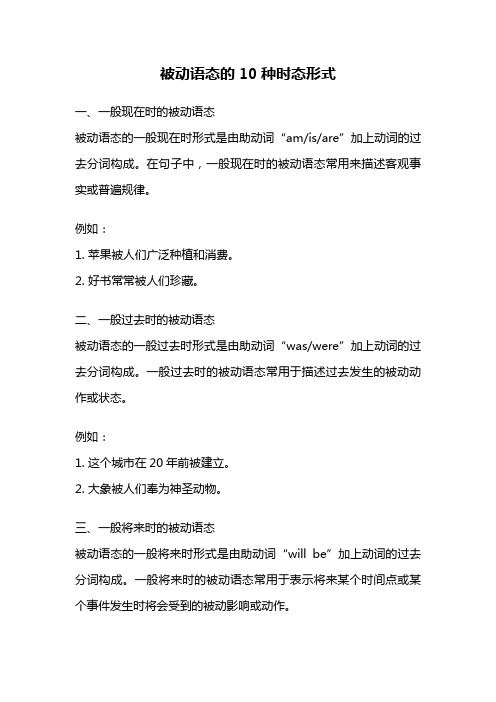
被动语态的10种时态形式一、一般现在时的被动语态被动语态的一般现在时形式是由助动词“am/is/are”加上动词的过去分词构成。
在句子中,一般现在时的被动语态常用来描述客观事实或普遍规律。
例如:1. 苹果被人们广泛种植和消费。
2. 好书常常被人们珍藏。
二、一般过去时的被动语态被动语态的一般过去时形式是由助动词“was/were”加上动词的过去分词构成。
一般过去时的被动语态常用于描述过去发生的被动动作或状态。
例如:1. 这个城市在20年前被建立。
2. 大象被人们奉为神圣动物。
三、一般将来时的被动语态被动语态的一般将来时形式是由助动词“will be”加上动词的过去分词构成。
一般将来时的被动语态常用于表示将来某个时间点或某个事件发生时将会受到的被动影响或动作。
例如:1. 这个问题将会被专家们讨论和解决。
2. 明天的比赛将会被全国观众关注。
四、现在进行时的被动语态被动语态的现在进行时形式是由助动词“am/is/are being”加上动词的过去分词构成。
现在进行时的被动语态常用于描述当前正在进行的被动动作。
例如:1. 这个项目正在被我们团队进行。
2. 正在播放的电影是由著名导演执导的。
五、过去进行时的被动语态被动语态的过去进行时形式是由助动词“was/were being”加上动词的过去分词构成。
过去进行时的被动语态常用于描述过去某个时间点正在进行的被动动作。
例如:1. 那个时候,这个城市正在被大规模改造。
2. 学生们在考试时都被要求保持安静。
六、将来进行时的被动语态被动语态的将来进行时形式是由助动词“will be being”加上动词的过去分词构成。
将来进行时的被动语态常用于描述将来某个时间点正在进行的被动动作。
例如:1. 明天这个时间段,这个工程将会被施工人员进行。
2. 下个月这个时候,我们将会被送到目的地。
七、现在完成时的被动语态被动语态的现在完成时形式是由助动词“have/has been”加上动词的过去分词构成。
中考英语各种时态的被动语态举例知识点总结
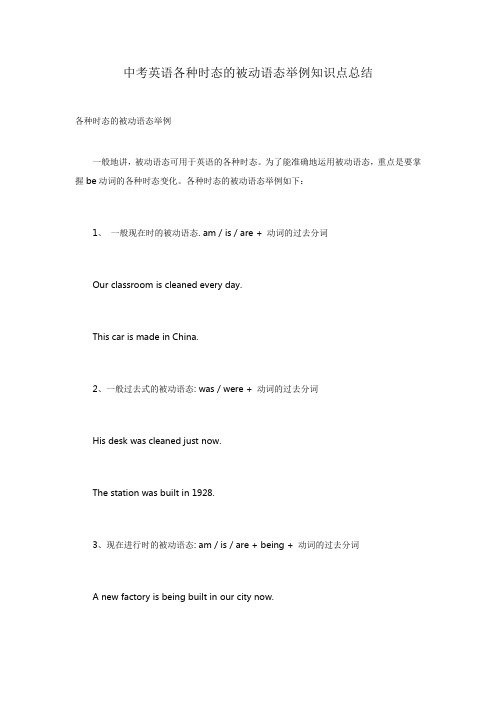
中考英语各种时态的被动语态举例知识点总结各种时态的被动语态举例一般地讲,被动语态可用于英语的各种时态。
为了能准确地运用被动语态,重点是要掌握be动词的各种时态变化。
各种时态的被动语态举例如下:1、一般现在时的被动语态. am / is / are + 动词的过去分词Our classroom is cleaned every day.This car is made in China.2、一般过去式的被动语态: was / were + 动词的过去分词His desk was cleaned just now.The station was built in 1928.3、现在进行时的被动语态: am / is / are + being + 动词的过去分词A new factory is being built in our city now.Some trees are being cut down in the park.4、过去进行时的被动语态: was / were + being + 动词的过去分词A new factory was being built in our city at that time.Some babies were being looked after by Miss Chen last year.5、一般将来时的被动语态:(A) will / shall + be + 动词的过去分词(B) am / is / are + going to be +动词的过去分词.Some new factories will be built in our city this year.Your watch is going to be mended in an hour.6、过去将来时的被动语态: (1).would / should + be + 动词的过去分词(2).was / were +going to be + 动词的过去分词.She said that some new factories would be built soon in our city.He thought that your watch was going to be mended after an hour.7、现在完成时的被动语态:have / has + been + 动词的过去分词Some new factories have been built in the city since last year.Your watch has been mended already.8、过去完成时的被动语态:had + been + 动词的过去分词He said that some new factories had been built in the city.I didn’t know that my watch had been mended .9、含情态动词的被动式:can/may/must + be + done例如:He can not be found. / I must be paid for this.。
高中英语被动语态
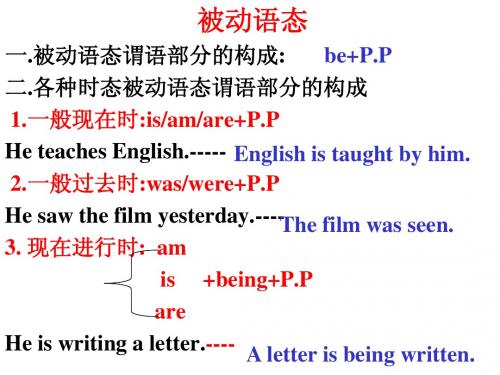
2). be going to be done We are going to finish the work on time. The work is going to be done by us on time. 8.含有情态动词的被动语态: can/may/must…be +P.P We must love our hometown. Our hometown must be loved by us. 9.特殊结的被动语态: have/has to be done seem to be done want sth to be done happen to be done ask sth to be done pretend to be done be happy to be done let sth be done
据说她要嫁给一个外国人。
It is rumored that he has been appointed as successo to the president of our company .
据传闻,他已任命为我们公司总裁的接班人了。
It is generally considered impolite to ask one’s age, salary, marriage, etc. 问别距太远而显得句 子松散,因为它的定太长了。)这个提议特别遭到了那些在
本地区投资很大的人的反对。
4.这里我们还要进一步谈谈几种特殊的被动结构。 1)关于带情态动词的被动结构 带情态动词的被动结构的固定句式为“情态动词 + be + 过去分词”。也有个别带“to”的情态动 词例外,如:ought to和have to ,它们的被动结 构就只能在不定式中,即ought/have to be done
16种时态及语态总结

16种时态及语态总结在英语学习中,时态和语态是非常重要的语法知识点。
它们能够帮助我们准确地表达时间、动作的状态以及主语和动词之间的关系。
下面就让我们一起来详细了解一下这 16 种时态及语态。
一、一般现在时(Simple Present Tense)一般现在时表示经常发生的动作、习惯性的行为、客观事实或真理等。
其结构为:主语+动词原形(当主语为第三人称单数时,动词要加“s”或“es”)例如:I play basketball every day (我每天打篮球。
)He likes music (他喜欢音乐。
)其被动语态结构为:am/is/are +过去分词例如:The book is read by many people (这本书被很多人读。
)二、一般过去时(Simple Past Tense)一般过去时用于描述过去发生的动作或存在的状态。
结构为:主语+动词的过去式比如:I went to Beijing last year (我去年去了北京。
)被动语态结构为:was/were +过去分词例如:The house was built in 1990、(这座房子建于 1990 年。
)三、一般将来时(Simple Future Tense)一般将来时表示将来要发生的动作或存在的状态。
结构有:will +动词原形或者 be going to +动词原形比如:I will visit my grandparents next week (下周我将看望我的祖父母。
)He is going to have a party tomorrow (他明天打算举办一个派对。
)其被动语态结构为:will be +过去分词或者 be going to be +过去分词例如:The meeting will be held next month (会议将在下个月举行。
)四、现在进行时(Present Continuous Tense)现在进行时表示正在进行的动作。
英语的16种时态、被动语态和例句分类总结

英语的16种时态,及其被动语态(be + V过去分词)。
1.一般现在时用原形V 或 V+esI often watch TV.我经常看电视。
TV is often watched by me.电视经常被我观看。
2.一般过去时用动词过去时I watched TV just now.我刚才还在看电视。
TV was watched by me just now.电视刚才被我看。
3. 一般将来时 will + 动词原形或be going to + 动词原形I will visit the zoo on Sunday.我星期天要去动物园。
The zoo will be visited by me on Sunday.这个动物园在星期天要被我参观。
(注意这里will可以用is going to代替)4. 过去将来时 would + 动词原形或 was/were going to + 动词原形Yesterday he told me he would visit the zoo next Sunday.昨天他告诉我他下个星期天要去动物园。
Yesterday he told me the zoo would be visited by him next Sunday. (单被动)Yesterday I was told by him the zoo would be visited by him next Sunday. (双被动) (注意,这里would 可以用 was going to 代替)5. 现在进行时 be + vingI am watching TV.我正在看电视。
TV is being watched by me.电视正在被我看。
6. 过去进行时 was/were + vingI was watching TV when you came in.当你进来的时候,我正在看电视。
TV was being watched by me when you came in. 当你进来的时候,电视正在被我看。
被动语态的不同时态
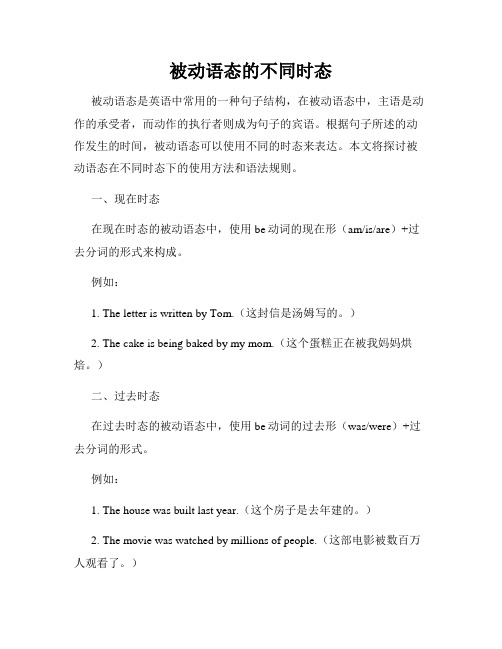
被动语态的不同时态被动语态是英语中常用的一种句子结构,在被动语态中,主语是动作的承受者,而动作的执行者则成为句子的宾语。
根据句子所述的动作发生的时间,被动语态可以使用不同的时态来表达。
本文将探讨被动语态在不同时态下的使用方法和语法规则。
一、现在时态在现在时态的被动语态中,使用be动词的现在形(am/is/are)+过去分词的形式来构成。
例如:1. The letter is written by Tom.(这封信是汤姆写的。
)2. The cake is being baked by my mom.(这个蛋糕正在被我妈妈烘焙。
)二、过去时态在过去时态的被动语态中,使用be动词的过去形(was/were)+过去分词的形式。
例如:1. The house was built last year.(这个房子是去年建的。
)2. The movie was watched by millions of people.(这部电影被数百万人观看了。
)三、将来时态在将来时态的被动语态中,使用will be +过去分词的形式来构成。
例如:1. The work will be finished by tomorrow.(这项工作将在明天之前完成。
)2. The report will be presented by our team.(这份报告将由我们团队提交。
)四、现在完成时态在现在完成时态的被动语态中,使用have been +过去分词的形式。
例如:1. The book has been read by many students.(这本书已经被很多学生阅读了。
)2. The project has been completed ahead of schedule.(这个项目提前完成了。
)五、过去完成时态在过去完成时态的被动语态中,使用had been +过去分词的形式。
例如:1. The car had been repaired before it broke down again.(这辆车在再次出故障之前已经修好了。
英语16大时态和8种被动语态
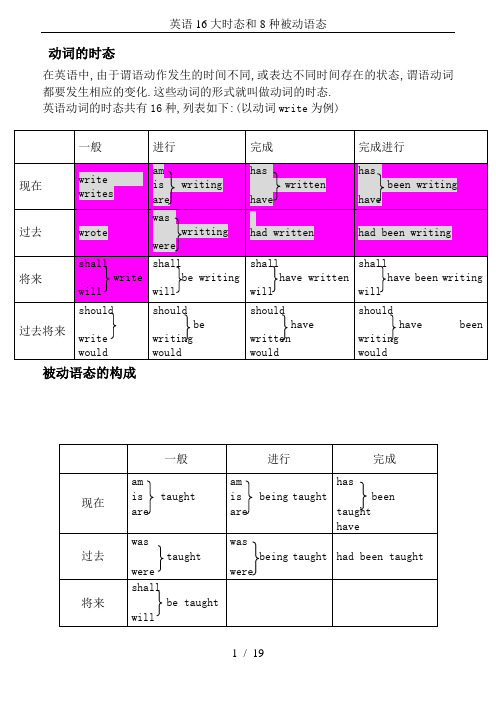
动词的时态在英语中,由于谓语动作发生的时间不同,或表达不同时间存在的状态,谓语动词都要发生相应的变化.这些动词的形式就叫做动词的时态.英语动词的时态共有16种,列表如下:(以动词write 为例)被动语态的构成一般 进行 完成 完成进行 现在 write writes am is writing arehas writtenhave has been writing have 过去wrote waswrittingwere had written had been writing 将来 shall write will shall be writing will shall have written will shall have been writingwill过去将来 should write wouldshouldbewritingwould should have written would should have been writing would 一般进行 完成 现在amis taughtare am is being taught are has been taught have 过去was taught were was being taught were had been taught 将来 shall be taught will被动语态由助动词be 加过去分词构成,时态通过be 表现出来.构成被动语态的一般疑问句时,须将第一个助动词移至主语之前,构成被动语态的否定句时,助动词后须加not. 各个时态的被动形式列表如下:(以动词teach 为例)英语被动语态讲解(一)语态的基本概念和种类语态是动词的一种形式,用来表明主语与谓语动词之间的关系。
所以英语的语态是通过动词形式的变化表现出来的。
语态有两种:主动语态和被动语态。
主语是动作的发出者为主动语态;主语是动作的接受者为被动语态。
英语16大时态及8种被动语态

动词的时态在英语中,由于谓语动作发生的时间不同,或表达不同时间存在的状态,谓语动词都要发生相应的变化.这些动词的形式就叫做动词的时态.英语动词的时态共有16种,列表如下:(以动词write为例)被动语态的构成被动语态由助动词be加过去分词构成,时态通过be表现出来.构成被动语态的一般疑问句时,须将第一个助动词移至主语之前,构成被动语态的否定句时,助动词后须加not. 各个时态的被动形式列表如下:(以动词teach为例)英语被动语态讲解(一)语态的基本概念和种类(二)语态是动词的一种形式,用来表明主语与谓语动词之间的关系。
所以英语的语态是通过动词形式的变化表现出来的。
语态有两种:主动语态和被动语态。
主语是动作的发出者为主动语态;主语是动作的接受者为被动语态。
(三)如:They built the bridge.(四) The bridge was built by them.(五)(二)被动语态的构成(六)被动语态由“助动词be+及物动词的过去分词”构成。
人称、数和时态的变化是通过be的变化表现出来的。
(七)歌诀是:被动语态be字变,过去分词跟后面。
(八)情态动词的被动语态是常考的一个知识点:情态动词+be+过去分词(九)(三)被动语态的用法(十)1)不知道或没有必要说明动作的执行者是谁。
例如:(十一)Some new computers were stolen last night. 一些新电脑在昨晚被盗了。
(不知道电脑是谁偷的)(十二)This book was published in 1981. 这本书出版于1981年。
(十三)(2)强调动作的承受者,而不强调动作的执行者。
例如:(十四)the window was broken by Mike. 窗户是迈克打破的。
(十五)This book was written by him. 这本书是他写的。
(十六)Eight hours per day for sleep must be guaranteed. 每天8小时睡眠必须得到保证。
- 1、下载文档前请自行甄别文档内容的完整性,平台不提供额外的编辑、内容补充、找答案等附加服务。
- 2、"仅部分预览"的文档,不可在线预览部分如存在完整性等问题,可反馈申请退款(可完整预览的文档不适用该条件!)。
- 3、如文档侵犯您的权益,请联系客服反馈,我们会尽快为您处理(人工客服工作时间:9:00-18:30)。
时态语态时态名称的“字眼组合”记忆法:4×4=16时间:现在,过去,将来,过去将来形态:一般,进行,完成,完成进行16种基本时态对应的被动语态1. 现在一般时的构成第一人称:动词原形第二人称:动词原形第三人称:动词原形+s,部分特殊词+es复数人称:动词原形现在一般时的【被动语态】构成第一人称:am + 动词的过去分词第二人称:are + 动词的过去分词第三人称:is + 动词的过去分词复数人称:are + 动词的过去分词2. 现在进行时的构成第一人称:am + 动词的现在分词第二人称:are + 动词的现在分词第三人称:is + 动词的现在分词复数人称:are + 动词的现在分词现在进行时的【被动语态】构成第一人称:am + being + 动词的过去分词第二人称:are + being + 动词的过去分词第三人称:is + being + 动词的过去分词复数人称:are + being + 动词的过去分词3、现在完成时的构成第一人称:have + 动词的过去分词第二人称:have + 动词的过去分词第三人称:has + 动词的过去分词复数人称:have + 动词的过去分词现在完成时的【被动语态】构成第一人称:have + been + 动词的过去分词第二人称:have + been + 动词的过去分词第三人称:has + been + 动词的过去分词复数人称:have + been + 动词的过去分词4、现在完成进行时的构成第一人称:have + been + 动词的现在分词第二人称:have + been + 动词的现在分词第三人称:has + been + 动词的现在分词复数人称:have + been + 动词的现在分词现在完成进行时的【被动语态】构成第一人称:have + been + being + 动词的过去分词第二人称:have + been + being + 动词的过去分词第三人称:has + been + being + 动词的过去分词复数人称:have + been + being + 动词的过去分词5. 过去一般时的构成第一人称:动词的过去式第二人称:动词的过去式第三人称:动词的过去式复数人称:动词的过去式过去一般时的【被动语态】构成第一人称:was + 动词的过去式第二人称:were + 动词的过去式第三人称:was + 动词的过去式复数人称:were + 动词的过去式6、过去进行时的构成第一人称:was + 动词的现在分词第二人称:were + 动词的现在分词第三人称:was + 动词的现在分词复数人称:were + 动词的现在分词过去进行时的【被动语态】构成第一人称:was + being + 动词的过去分词第二人称:were + being + 动词的过去分词第三人称:was + being + 动词的过去分词复数人称were + being + 动词的过去分词7、过去完成时的构成第一人称:had + 动词的过去式第二人称:had + 动词的过去式第三人称:had + 动词的过去式复数人称:had + 动词的过去式过去完成时的【被动语态】构成第一人称:had + been + 动词的过去式第二人称:had + been + 动词的过去式第三人称:had + been + 动词的过去式复数人称:had + been + 动词的过去式8、过去完成进行时的构成第一人称:had + been + 动词的现在分词第二人称:had + been + 动词的现在分词第三人称:had + been + 动词的现在分词复数人称:had + been + 动词的现在分词过去完成进行时的【被动语态】构成第一人称:had + been + being + 动词的过去分词第二人称:had + been + being + 动词的过去分词第三人称:had + been + being + 动词的过去分词复数人称had + been + being + 动词的过去分词9、将来一般时的构成第一人称:will/shall/am going to + 动词原形第二人称:will/are going to + 动词原形第三人称:will/is going to + 动词原形复数人称:will/are going to + 动词原形将来一般时【被动语态】的构成第一人称:will/shall/am going to + be + 动词的过去分词第二人称:will/are going to + be + 动词的过去分词第三人称:will/is going to + be + 动词的过去分词复数人称:will/are going to + be + 动词的过去分词10、将来进行时的构成第一人称:will/shall/am going to + be + 动词的现在分词第二人称:will/are going to + be + 动词的现在分词第三人称:will/am going to + be + 动词的现在分词复数人称:will/are going to + be + 动词的现在分词将来进行时【被动语态】的构成第一人称:will/shall/am going to + be + being + 动词的过去分词第二人称:will/are going to + be + being + 动词的过去分词第三人称:will/am going to + be + being + 动词的过去分词复数人称:will/are going to + be + being + 动词的过去分词11、将来完成时的构成第一人称:will + have + 动词的过去分词第二人称:will+ have + 动词的过去分词第三人称:will+ have + 动词的过去分词复数人称:will+ have + 动词的过去分词将来完成时【被动语态】的构成第一人称:will + have + been + 动词的过去分词第二人称:will+ have + been + 动词的过去分词第三人称:will+ have + been + 动词的过去分词复数人称:will+ have + been + 动词的过去分词12、将来完成进行时的构成第一人称:will + have + been + 动词的现在分词第二人称:will + have + been + 动词的现在分词第三人称:will + have + been + 动词的现在分词将来完成进行时【被动语态】的构成第一人称:will/shall/am going to + be + being + 动词的过去分词第二人称:will/are going to + be + being + 动词的过去分词第三人称:will/am going to + be + being + 动词的过去分词复数人称:will/are going to + be + being + 动词的过去分词13、过去将来一般时的构成第一人称:will/shall/was going to + 动词原形第二人称:will/were going to + 动词原形第三人称:will/was going to + 动词原形复数人称:will/were going to + 动词原形过去将来一般时的【被动语态】构成第一人称:will/shall/was going to + be + 动词的过去分词第二人称:will/were going to + be + 动词的过去分词第三人称:will/was going to + be + 动词的过去分词复数人称:will/were going to + be + 动词的过去分词14、过去将来进行时的构成第一人称:will/shall/was going to + be + 动词的现在分词第二人称:will/were going to + be + 动词的现在分词第三人称:will/was going to + be + 动词的现在分词复数人称:will/were going to + be + 动词的现在分词过去将来进行时的【被动语态】构成第一人称:will/shall/was going to + be + being + 动词的过去分词第二人称:will/were going to + be + being + 动词的过去分词第三人称:will/was going to + be + being + 动词的过去分词复数人称:will/were going to + be + being + 动词的过去分词15、过去将来完成时的构成第一人称:would + have + 动词的过去分词第二人称:would + have + 动词的过去分词第三人称:would + have + 动词的过去分词复数人称:would + have + 动词的过去分词过去将来完成时的【被动语态】构成第一人称:would + have + been + 动词的过去分词第二人称:would + have + been + 动词的过去分词第三人称:would + have + been + 动词的过去分词复数人称:would + have + been + 动词的过去分词16、过去将来完成进行时的构成第一人称:will + have + been + 动词的现在分词第二人称:will + have + been + 动词的现在分词第三人称:will + have + been + 动词的现在分词过去将来完成进行时的【被动语态】构成第一人称:will + have + been + being + 动词的过去分词第二人称:will + have + been + being + 动词的过去分词第三人称:will + have + been + being + 动词的过去分词复数人称:will + have + been + being + 动词的过去分词规律:1、表进行全部有“现在分词”。
现在进行助动词用“is, am, are”;过去进行助动词用“was, were”。
2、表被动和完成全部有“过去分词”。
现在完成助动词用“have”第三人称特殊用“has”;过去完成助动词用“had”。
3、词不够,“be”来凑。
“be”在“have”后; “has”后要用“been”。
4、非谓语动词不用助动词。
